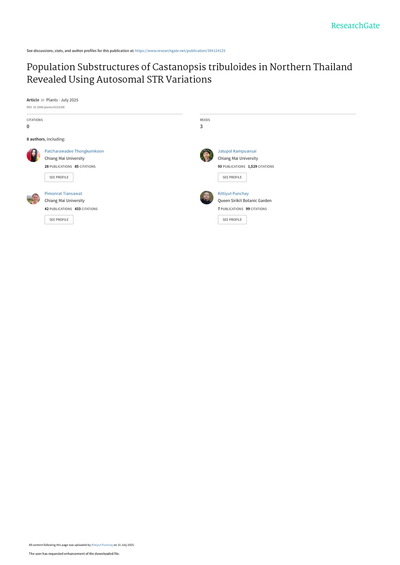Population substructures of Castanopsis tribuloides in northern Thailand revealed using autosomal STR variations

Thongkumkoon, P., J. Kampuansai, M. Dansawan, P. Tiansawat, N. Noirungsee, K. Punchay, N. Khamyong, P. Wangpakapattanawong. Population substructures of Castanopsis tribuloides in northern Thailand revealed using autosomal STR variations. Plants 2025, 14, 2306. https://doi.org/10.3390/plants14152306
Contributors
This study investigates the genetic diversity and population structure of Castanopsis tribuloides, a vital tree species in Asian forest ecosystems. Understanding the genetic patterns of keystone forest species provides critical insights into forest resilience and ecosystem function and informs conservation strategies. We analyzed population samples collected from three distinct locations within Doi Suthep Mountain in northern Thailand using Short Tandem Repeat (STR) markers to assess both intra- and inter-population genetic relationships. DNA was extracted from leaf samples and analyzed using a panel of polymorphic microsatellite loci specifically optimized for Castanopsis species. Statistical analyses included the assessment of forensic parameters (number of alleles, observed and expected heterozygosity, gene diversity, polymorphic information content), population differentiation metrics (GST), inbreeding coefficients (FIS), and gene flow estimates (Nm). We further examined population history through bottleneck analysis using three models (IAM, SMM, and TPM) and visualized genetic relationships through principal coordinate analysis and cluster analysis. Our results revealed significant patterns of genetic structuring across the sampled populations, with genetic distance metrics showing statistically significant differentiation between certain population pairs. The PCA and cluster analyses confirmed distinct population groupings that correspond to geographic distribution patterns. These findings provide the first comprehensive assessment of C. tribuloides population genetics in this region, establishing baseline data for monitoring genetic diversity and informing conservation strategies. This research contributes to our understanding of how landscape features and ecological factors shape genetic diversity patterns in essential forest tree species, with implications for managing forest genetic resources in the face of environmental change.



